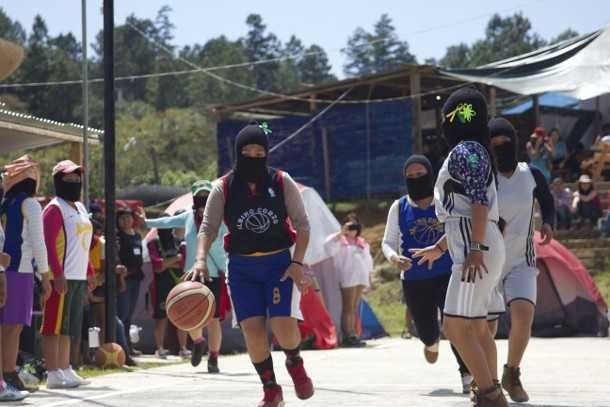Shirin Hess
April 3, 2018Source: Waging Non Violence
Dawn had only just broken over the mountains. While most of the women and children on the camping grounds were still asleep, others were already wide awake, huddling together in the first rays of sunlight and drinking coffee.
To a casual observer, this place might have seemed similar to any mainstream festival campsite. A distinguishing factor, however, was that there wasn’t a single man in sight. The sign on the main entrance left no one in doubt that only women and children were welcome at this event: “Men not permitted to enter.”
Women’s participation in Mexico’s 25-year-old Zapatista National Liberation Army, or EZLN movement, has represented an incredible organizational achievement since its original uprising in 1994. On International Women’s Day, the female militants of the EZLN did not fail to meet expectations when welcoming 7,000 people to the “First International Political, Artistic, Sports, and Cultural Encounter for Women who Struggle.”
Two thousand indigenous Zapatista women from various parts of Chiapas state and 5,000 visitors from all over the world came to Caracol Morelia, near the northeastern town of Altamirano, to hear what they had to say.
Uniting women
The event was entirely initiated by women of the EZLN. They planned it from beginning to end, and made sure everyone who attended was allocated a sleeping place, had access to drinking water and was cared for in the case they fell sick during the three days the event took place. Zapatista events such as these have commonly been accessible via invitation only. This event differed from most of the EZLN’s previous “Escuelitas,” or “Little Schools,” summoning all women and children who were interested in the struggle to overcome misogynistic culture.
“What we wanted was to meet many women,” said Commander Jenny, who coordinated the event. “We thought that only a few women were going to come, so we are very happy to see how many of you have joined us here.” Although only her eyes were visible, a smile was detectable behind her black balaclava. “It has been hard work, but we are very pleased to see that there are many other women who are fighting patriarchy.”
The event was not only an opportunity to create educational or professional networks, but also a space to consider one’s health and well-being as a woman in the fight for justice. There were activities ranging from workshops, discussion panels and movie screenings to theater performances, art exhibitions and sports events, including basketball and soccer matches. Themes included gender violence, self-defense, self-care, sexism in the media, sexual rights, health and education, misogyny and childhood, discrimination against indigenous LGBTQ communities, women environmental rights defenders, and decolonization. All of the activities were led and held by women, and all of them were aimed at generating consciousness of gender inequality or the restoration of women’s self-confidence and autonomy.
“Capitalism is not only colonial, it is also patriarchal and racist,” said Fernanda Esquivel, a 20-year-old student from Guadalajara. “ To come here and see that the Zapatistas are still resisting and have resisted for so many years is a huge inspiration for me. Being with so many women and feeling united also makes me feel hopeful about really creating a change. In academia there is nothing that can show you what it is like to come here, and to feel and share these experiences in practice.”
Young women like Esquivel have grown up watching the Zapatistas evolve and followed their fight through media reports, the Zapatista’s own communication channel, “Zapatista Connection,” and more recently a Facebook page and YouTube account. Women from a total of 42 different countries, some of whom were already familiar with women’s movements or other social, political or environmental activism, attended the event in hopes that they would gain skills and inspiration from the women’s Zapatista struggle.
“Apart from wanting to amplify my vision of how different fights against the extractive industries are developing,” said Katherin Cruz from the National Network of Women Human Rights Defenders in Honduras, which accompanies women human rights defenders involved in territorial conflicts. “I came here so I could recharge my batteries and take home experiences that strengthen me individually and prepare me for the work that I do, and for my political activism within the feminist movement in Honduras.”

The birth of the EZLN
In 1983, a group of indigenous peasants in Chiapas organized in secret, educating themselves politically and creating an entirely unique philosophy that insisted that “another world is possible,” one that focuses on collectivity, serving the Zapatista community and creating an autonomous social and economical environment for themselves within neoliberal and capitalist Mexico. Finally on January 1,1994 the group went public, calling themselves the Zapatista National Liberation Army, named after the hero of the 1910 Mexican Revolution, Emiliano Zapata. That day, the EZLN launched an armed uprising, occupied seven towns in Chiapas, including San Cristóbal, and declared war on the Mexican government.
During their brief occupation, followed by a 12-day battle, the EZLN criticized the effects of global capitalism on local farmers and indigenous land. They drew attention in particular to the North American Free Trade Agreement, or NAFTA, calling it a death sentence for the indigenous peasants of Mexico. NAFTA would be responsible for dismantling collective land rights secured by the Mexican constitution and prioritizing export manufacturing. The Zapatistas fought for a fairer distribution of wealth, as well as the right to political participation for indigenous people in Mexico.

After their initial uprising, in 1996 the Zapatista organization gained constitutional recognition from the state through the San Andres Accords and formed the National Indigenous Council. The Mexican government did not comply with the agreements and the Zapatistas continued to suffer from violent attacks, such as the Acteal Massacre in 1997, where 45 Zapatista sympathizers were killed in Chiapas. Since then, they have peacefully organized mass marches and protests, created their “caracoles,” or administrative headquarters, formed autonomous governance, justice, health and education systems and launched public campaigns drawing attention to continued racism and discrimination in Mexico. According to the Mexican newspaper El Universal, the EZLN now governs over 250,000 indigenous people living in the Autonomous Rebellious Zapatista Municipalities in Chiapas.
Today, the image of the Zapatista soldiers, clad in red scarves and balaclavas, has reached some of the most remote corners of the world. Their movement is now well known for its transition from armed struggle to nonviolent resistance to advance their demands for indigenous land rights and autonomy, which has triggered tremendous support and solidarity from anti-capitalist activists globally. However, many of the major issues for indigenous communities addressed by the Zapatistas, such as abandonment and marginalization, continue to exist in Chiapas and other parts of impoverished Mexico.
Women’s involvement and participation
During the gathering, Commander Marina took the stage to tell the story of the first female Zapatistas, their struggle for recognition in a male-dominated space and their experience of clandestine meetings prior to their public appearance in 1994. “We took our safety very seriously so that no one would realize where we were going. We had meetings in the mountains, these were very important. We had talks on politics, read books and watched films. We studied the situation of poverty our community was submerged in,” she said. “There was nothing to gain trying to demand things from our bad government.”
The backdrop of the women’s movement within the Zapatista struggle reveals extreme levels of violence against women, poverty and abandonment from any sort of federal health or educational institutions. Intersectional discrimination for being poor, indigenous and women was commonplace, and girls were often forced into marriages or sold by their fathers or families. During the opening ceremony of the encounter, the Zapatistas made it clear that women were sidelined and perceived by the community as second-class citizens. According to Commander Flor, even “midwives would charge less when girls were born.”

Their struggle has led the women in the ranks of the EZLN — which comprise about a third of the organization’s participants — to see themselves from a different perspective and shed light on the problematic behaviour caused by gender inequality. “At the beginning, we were not used to saying our opinions, or having discussions. We would all agree to everything and nod our heads,” Marina said. “We had to fight among our own compañeros, since it took a lot for them to understand the rights we have as women. There is a lot left to achieve but we are convinced that we will accomplish our ideals because we are organized, and we are strong as a collective. We have put fear and doubt aside.”
Many followers of the Zapatista revolution were not aware of the key elements that formed the movement before going public in 1994. Undeniably, one of the key characteristics that shaped the movement was the “Women’s Revolutionary Law,” passed by the Zapatista committees in 1992.
For Sylvia Marcos, a sociologist and expert on indigenous movements across the Americas, the emphasis on women’s rights is a defining factor for the organization. Furthermore, she indicates that these rights were claimed not solely for women as individuals, but were “fully linked and interwoven with collective rights.”
The unique transformations achieved by the Zapatista indigenous movement are manifest in its attempt to re-imagine gender and decolonize oppressive discourse for the sake of personal empowerment.
Enduring inspiration
Over the last three decades, the revolution continues to abide by laws made by the autonomous Zapatista government. With military strategist and spokesperson Subcomandante Marcos “resigning” from his activities, the Zapatistas have moved out of the media spotlight. However, the successful turnouts for their events prove that the Zapatistas are still an important source of inspiration for social mobilizations and women’s movements today.
Not simply an iconic reminder of what indigenous communities were up against in the past, the Zapatistas are engaging in great efforts to revise their strategies and continue to create networks of people who resist, especially among women. Though alternative visions of gender relations have flourished among the Zapatistas, women in the movement continue to suffer gender violence and are battling other issues not uncommon in Chiapas, such as malnutrition, and lack of access to health care and education.
The Zapatistas are addressing some of these issues through their own internal initiatives. Part of their collective work towards independence and sustainability relies on their agroecological farming projects, coffee sales, cooperative shops, community kitchens, traditional medicine and tortilla businesses. However, the fundamental purpose of the Zapatista movement is to promote their way of life and organize collective resistance to resource appropriation, historically-determined economic and social disadvantages and institutional neglect, which exacerbate poverty, sustain the governmental elite and destroy local traditions. Much of their work revolves around inspiring new generations to begin their own journey towards deconstructing norms in their respective societies.
The Zapatista movement currently functions like an organization that promotes constructive dialogue, communication and continued reflection on problems that affect their communities, as well as a support network for other national movements, including the water conflict affecting the indigenous Yaqui community, the 43 Ayotzinapa students missing since 2014 and the recent presidential campaign by the indigenous activist Maria de Jesus Patricio Martinez.
Women’s participation within the EZLN has played a key role in their success and ideology. They have made it clear that there will be no democracy without them. What the event last month demonstrated to many of those who were present, was the need to create safe spaces for all women, which allow them to heal and inspire them to continue fighting their own battles in their own ways. “We made an agreement, and that agreement was to live!” Commander Marina said. “And since, for us, living is fighting, we agreed to fight — each of us according to our means, our place and our time.”
Article originally published on Waging Non Violence

